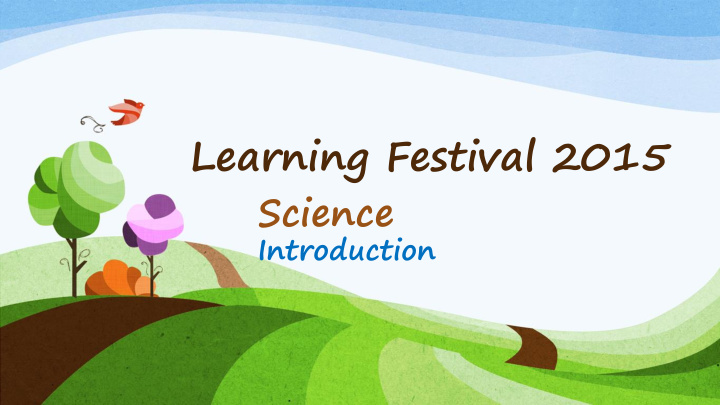



Learning Festival 2015 Science Introduction
21 st Century Competencies Purpose Habits of Mind • Prepare pupils for life and • Adaptability work in the 21 st century • Critical thinking • Reduce rote learning and • Social skills memory work • Self management • Increased focus on complex communication • Conceptual knowledge (Interaction, Information processing, Explanation, • Problem solving Persuasion)
What does my child learn How does my child learn in science? science? Why does my child learn science? How is my child assessed How can I support my in science? child in learning science?
Learn basic concepts to understand themselves and things around them Why does my child learn science? Develop skills Cultivate attitudes Have learning experiences which build on interest and stimulate curiosity
What does my child learn in science? • Learn basic concepts, develop basic skills, cultivate attitudes Apply concepts and skills in different contexts • Ask questions / predict Do simple hands-on activities / observe Explain observations and make connections
How does my child learn science? Inquiry-based Learning • Focus on developing cognitive abilities Reasoning Constructing argument Explaining Critical thinking Communicating
How is my child assessed in science? • Application of concepts and skills Explain their understanding of concepts in their own words Show concepts which are correct in relation to the questions
Fact / Concept ? • Water freezes to • When water loses become ice. heat, it changes its state from liquid to solid. • Caterpillars are • Any animals with 6 insects. legs are known as insects.
How can I support my child in learning science? What characteristics does How do I keep my drink this animal have? hot for a longer time? How tall has my brother grown? How does this toy work? Science in Everyday Life Be curious . Ask questions. Which materials should Why do I need to wear gloves I use to make the curtain when I hold a hot pot? in my room? Why does the ball always Why do I not fall when walking? fall to the ground? How can I conserve energy at home?
Learning Festival 2015 Science Questioning Technique (Process Skills)
Lesson Demonstration • Going through a typical Science question • Importance of questioning
Dispersal of fruits and seeds • Wind • Fruits and seeds dispersed by wind are often dry and light. angsana • Some of them have wing-like structures. • They are easily carried by wind. lalang dandelion
http://waynesword.palomar.edu/plfeb99.htm This is a “whirling nut”. An interesting one-seeded winged fruit that spins as it falls through the air. http://upload.wikimedia.org/wikipedia/commons/a/ac/Photos-photos_1088103921_Floating.jpg Dandelion seeds can be carried long distances by the wind. They are light and hairy.
Dispersal of fruits and seeds • Animals • Some fruits can be eaten by animals. • Their seeds are thrown away or passed out in the animals’ droppings if swallowed. kiwi papaya watermelon
Love Grass has hooks which can easily stick to people's socks and pants as they walk in the fields. http://plantspedia.org/info/Image:Big_Burrs.jpg http://sci-ctr.edu.sg/ssc/wildflowers/travel.jsp This is a Teasel Burr. The seeds have hooks which attach themselves to fur or clothing of passing animals or people and then drop off later.
http://andromeda.cavehill.uwi.edu/Dispersal.htm#Water%20Dispersal: This is a cluster of grapefruit. http://plantspedia.org/info/Image:Cherry_by_Gulmammad_2.jpg The flesh is eaten by animals and the seeds are passed out or These are cherries. These seeds with fleshy discarded at another location. covering are eaten by animals such as birds and mammals which then disperse these seeds in their droppings.
Dispersal of fruits and seeds • Water • Their fruits have fibrous husks which allows them to float on water • They are usually found in water bodies.
Dispersal of fruits and seeds • Splitting or Explosive Action • The seeds are contained in pods or capsules, and when they have dried, it disperses its seed by splitting or explosive action. Sandbox seed capsule Seed capsule ruptures and releases flat round seeds Dry seedpods split along their seams to scatter their Sandbox tree has seeds fruits which are dispersed by explosive action
Questions and its Purpose • What is similar between the three diagrams? (observing the diagrams) • What is different about the three diagrams? (compare the position of the seeds) • What is different about the position of the seeds? (inferring the situation given) • Which pattern is created by wind? Why? (start the child’s thinking on the rest of the question)
Objectives Behind Asking More • Learn independently • Develop critical thinking
Questions that you can ask your child
Learning Festival 2015 Science at Home
Benefits of conducting experiments … • Fun for children • My Dad / Mom is a superhero • Children learn better by doing • Process skills acquisition Observing Communicating Analysing • • • Comparing Inferring Generating possibilities • • • Classifying Formulating hypothesis Evaluating • • • Using apparatus Predicting • •
In an experiment … • Aim • Prediction • Set-up and variables • Observation • Record • Conclusion • Explanation
AIM: • To find out how the size of a coin affects the number of water droplets it can hold PREDICTION: • The larger the coin, the more the water droplets it can hold.
SETUP: VARIABLES: • The type of dropper • Side of coin • Type of liquid • Room / environment
Observation: • Carry out the experiment
Record: Number of Drops of 50 cents 20 cents 10 cents 5 cents water Added Parent A Parent B Parent C
CONCLUSION: • The larger the coin, the more water droplets it can hold. EXPLANATION: • The larger coin provides more surface area for water to rest on.
Suggested activities that can become experiments: • When hanging out clothes to dry • Watering a plant
Learning Festival 2015 Science Conclusion
Science is a way of thinking much more than it is a body of knowledge. - Carl Sagan
Recommend
More recommend